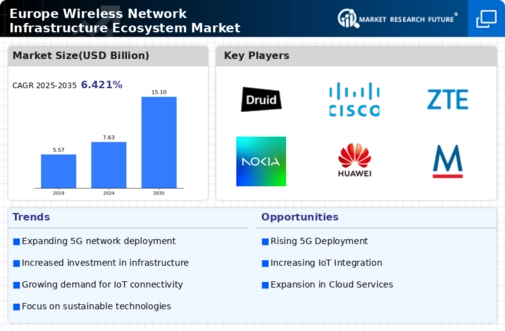The competitive landscape of the Europe Wireless Network Infrastructure Ecosystem Market encompasses a diverse array of key players and innovative solutions, driving advancements in connectivity and network efficiency. This market is characterized by rapid technological progress, investment in research and development, and a strong focus on meeting the stringent regulatory requirements of the region. The competition is intense, with players striving to differentiate their offerings through superior service quality, enhanced capabilities, and strategic partnerships.
Companies are increasingly focusing on the deployment of next-generation technologies such as 5G, which facilitates greater data transfer speeds and connectivity solutions across various industries. The collaboration between network providers, technology developers, and infrastructure suppliers forms a crucial part of this ecosystem, enabling the creation of scalable, reliable, and secure wireless network infrastructures that meet the demands of both consumers and enterprises alike.
Druid Software has established itself as a prominent player within the Europe Wireless Network Infrastructure Ecosystem Market, renowned for its innovative software solutions that enhance network performance and management capabilities. The company’s strengths lie in its agile architecture, allowing for seamless integration into existing network infrastructures while providing robust features that support extensive scalability.
Druid Software’s presence in various European markets is bolstered by its commitment to customer-centric approaches, ensuring that its solutions are tailored to meet specific regional requirements. Additionally, its dedication to research and development fosters continuous improvement, showcasing a strong potential for further growth in the competitive landscape. By focusing on creating flexible and adaptable software platforms, Druid Software effectively positions itself to address the evolving needs of wireless network operators throughout Europe.
Samsung Electronics plays a significant role in the Europe Wireless Network Infrastructure Ecosystem Market, leveraging its extensive portfolio of products and services tailored to enhance wireless connectivity. The company is known for offering state-of-the-art network solutions, including advanced 5G infrastructure, radio access networks, and cutting-edge network management software, all designed to meet the demands of various European operators. Samsung's market presence across Europe is supported by strategic partnerships and collaborations with key telecommunications providers.
The company’s strengths include its advanced technological capabilities, innovative research and development initiatives, and a keen understanding of the local market dynamics. Recently, Samsung Electronics has been involved in pivotal mergers and acquisitions that enhance its competitive positioning, facilitate the expansion of its service offerings, and consolidate its influence within the European wireless network landscape. By continuously investing in technology and fostering collaborative relationships, Samsung Electronics is well-poised to influence the trajectory of the wireless infrastructure sector in Europe.






















Leave a Comment